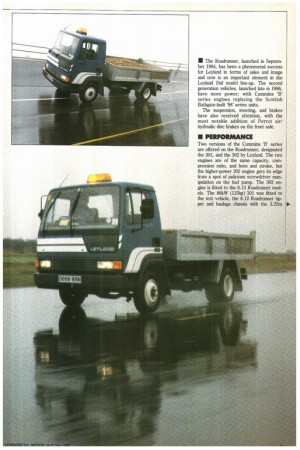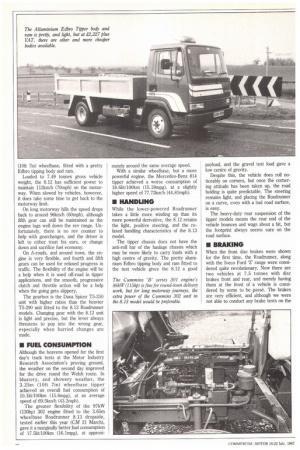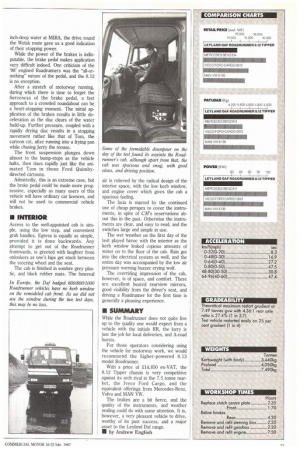ROADRUNNER'S SECOND WIND
Page 32

Page 33

Page 34

Page 35

If you've noticed an error in this article please click here to report it so we can fix it.
• The Roadrunner, launched in September 1984, has been a phenomenal success for Leyland in terms of sales and image and now is an important element in the Leyland Daf model line-up. The second generation vehicles, launched late in 1986, have more power; with Cummins `B' series engines replacing the Scottish Bathgate-built '98' series units.
The suspension, steering, and brakes have also received attention, with the most notable addition of Perrot air/ hydraulic disc brakes on the front axle.
Two versions of the Cummins 'B' series are offered on the Roadrunner, designated the 301, and the 302 by Leyland. The two engines are of the same capacity, compression ratio, and bore and stroke, but the higher-power 302 engine gets its edge from a spot of judicious screwdriver manipulation on the fuel pump. The 302 engine is fitted to the 8.13 Roadrunner models. The 86kW (115hp) 301 was fitted to the test vehicle, the 8.12 Roadrunner tipper and haulage chassis with the 3.25m (10ft 7in) wheelbase, fitted with a pretty Edbro tipping body and ram.
Loaded to 7.49 tonnes gross vehicle weight, the 8.12 has sufficient power to maintain 112km/h (70mph) on the motorway. When slowed by vehicles, however, it does take some time to get back to the motorway limit.
On long motorway hills the speed drops back to around 961cm/h (60mph), although fifth gear can still be maintained as the engine lugs well down the rev range. Unfortunately, there is no rev counter to help with gearchanges, and the driver is left to either trust his ears, or change down and sacrifice fuel economy.
On A-roads, and around town, the engine is very flexible, and fourth and fifth gears can be used for relaxed progress in traffic. The flexibility of the engine will be a help when it is used off-road in tipper applications, and the smooth, progressive clutch and throttle action will be a help when the going gets slippery.
The gearbox is the Dana Spicer T5-250 unit with higher ratios than the heavier 15-290 unit fitted to the 8.13 Roadrunner models. Changing gear with the 8.12 unit is light and precise, but the lever always threatens to pop into the wrong gear, especially when hurried changes are made.
• FUEL CONSUMPTION
Although the heavens opened for the first day's track tests at the Motor Industry Research Association's proving ground, the weather on the second day improved for the drive round the Welsh route. In blustery, and showery weather, the 3.25m (10ft 7in) wheelbase tipper achieved an overall fuel consumption of 10.1lit/1001cm (15.6mpg), at an average speed of 69.5kinih (43.2mph).
The greater flexibility of the 97kW (130hp) 302 engine fitted to the 3.65m wheelbase Roadrunner 8.13 dropside, tested earlier this year (CM 21 March), gave it a marginally better fuel consumption of 17.5lit/100km (16.1mpg), at approxi mately around the same average speed.
With a similar wheelbase, but a more powerful engine, the Mercedes-Benz 814 tipper achieved a worse consumption of 18. 61i t/10 Okm (15. 19mpg), at a slightly higher speed of 77.72km/h (44.81mph).
While the lower-powered Roadrunner takes a little more winding up than its more powerful derivative, the 8.12 retains the light, positive steering, and the relaxed handling characteristics of the 8.13 model.
The tipper chassis does not have the anti-roll bar of the haulage chassis which may be more likely to carry loads with a high centre of gravity. The pretty aluminium Edbro tipping body and ram fitted to the test vehicle gives the 8.12 a good The Cummins 'B' series 301 engine's 86kW (115hp) is fine for round-town delivery work, but for long motorway journeys, the extra power of the Cummins 302 unit in the 8.13 model would be preferable. payload, and the gravel test load gave a low centre of gravity.
Despite this, the vehicle does roll noticeably on corners, but once the cornering attitude has been taken up, the road holding is quite predictable. The steering remains light, and placing the Roadrunner on a curve, even with a bad road surface, is easy.
The heavy-duty rear suspension of the tipper models means the rear end of the vehicle bounces and wags about a bit, but the footprint always seems sure on the road surface.
When the front disc brakes were shown for the first time, the Roadrunner, along with the Iveco Ford 'Z' range were considered quite revolutionary. Now there are two vehicles at 7.5 tonnes with disc brakes front and rear, and merely having them at the front of a vehicle is considered by some to be passé. The brakes are very efficient, and although we were not able to conduct any brake tests on the inch-deep water at MIRA, the drive round the Welsh route gave us a good indication of their stopping power.
While the power of the brakes is indisputable, the brake pedal makes application very difficult indeed. One criticism of the '98' engined Roadrunners was the "all-ornothing" nature of the pedal, and the 8.12 is no exception.
After a stretch of motorway running, during which there is time to forget the fierceness of the brake pedal, a fast approach to a crowded roundabout can be a heart-stopping moment. The initial application of the brakes results in little deceleration as the disc clears of the water build-up. Further pressure, coupled with a rapidly drying disc results in a stopping movement rather like that of Tom, the cartoon cat, after running into a frying pan while chasing Jerry the mouse.
The front suspension plunges down almost to the bump-stops as the vehicle halts, then rises rapidly just like the animated Tom in those Fred Quimbydirected cartoons.
Admittedly, this is an extreme case, but the brake pedal could be made more progressive, especially as many users of this vehicle will have ordinary car licences, and will not be used to commercial vehicle brakes.
Access to the well-appointed cab is simple, using the low step, and convenient grab handles. Egress is equally as simple, provided it is done backwards. Any attempt to get out of the Roadrunner frontwards, is greeted with laughter from onlookers as one's hips get stuck between the steering wheel and the seat.
The cab is finished in sombre grey plastic, and black rubber mats. The funereal In Europe, the Daf badged 600180011000 Roadrunner vehicles have no kerb window on the remodeled cab front. As we did not use the window during the two test days, this may be no loss. air is relieved by the radical design of the interior space, with the low kerb window, and engine cover which gives the cab a spacious feeling.
The facia is marred by the continued use of cheap perspex to cover the instruments, in spite of CM's reservations about this in the past. Otherwise the instruments are clear, and easy to read, and the switches large and simple in use.
The wet weather on the first day of the test played havoc with the interior as the kerb window leaked copious amounts of water on to the floor of the cab. Rain got into the electrical system as well, and the entire day was accompanied by the low air pressure warning buzzer crying wolf.
The overriding impression of the cab, however, is of space, and comfort. There are excellent heated rearview mirrors, good visibility from the driver's seat, and driving a Roadrunner for the first time is generally a pleasing experience.
While the Roadrunner does not quite live up to the quality one would expect from a vehicle with the initials RR, the lorry is Just the job for local deliveries, and A-road bursts.
For those operators considering using the vehicle for motorway work, we would recommend the higher-powered 8.13 model Roadrunner.
With a price of £14,850 ex-VAT, the 8.12 Tipper chassis is very competitive against its arch rival in the 7.5 tonne market, the Iveco Ford Cargo, and the equivalent offerings from Mercedes-Benz, Volvo and MAN VW.
The brakes are a bit fierce, and the quality of the instruments, and weather sealing could do with some attention. It is, however, a very pleasant vehicle to drive, worthy of its past success, and a major asset to the Leyland Daf range.
• by Andrew English












































































